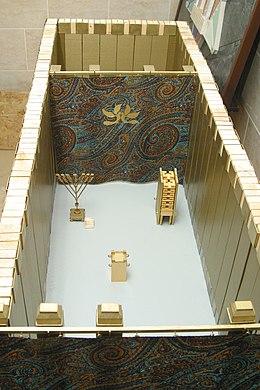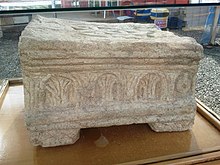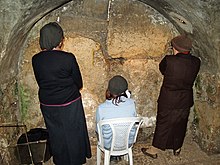
The menorah is a seven-branched candelabrum that is described in the Hebrew Bible and in later ancient sources as having been used in the Tabernacle and in the Temple in Jerusalem.

The Temple in Jerusalem, or alternatively the Holy Temple, refers to the two religious structures that served as the central places of worship for Israelites and Jews on the modern-day Temple Mount in the Old City of Jerusalem. According to the Hebrew Bible, the First Temple was built in the 10th century BCE, during the reign of Solomon over the United Kingdom of Israel. It stood until c. 587 BCE, when it was destroyed during the Babylonian siege of Jerusalem. Almost a century later, the First Temple was replaced by the Second Temple, which was built after the Neo-Babylonian Empire was conquered by the Achaemenid Persian Empire. While the Second Temple stood for a longer period of time than the First Temple, it was likewise destroyed during the Roman siege of Jerusalem in 70 CE.
Kohen is the Hebrew word for "priest", used in reference to the Aaronic priesthood, also called Aaronites or Aaronides. They are traditionally believed and halakhically required to be of direct patrilineal descent from the biblical Aaron, brother of Moses, and thus belong to the Tribe of Levi.

According to the Hebrew Bible, the tabernacle, also known as the Tent of the Congregation, was the portable earthly dwelling used by the Israelites from the Exodus until the conquest of Canaan. Moses was instructed at Mount Sinai to construct and transport the tabernacle with the Israelites on their journey through the wilderness and their subsequent conquest of the Promised Land. After 440 years, Solomon's Temple in Jerusalem superseded it as the dwelling-place of God.
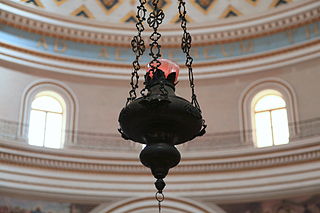
A sanctuary lamp, chancel lamp, altar lamp, everlasting light, or eternal flame is a light that shines before the altar of sanctuaries in many Jewish and Christian places of worship. Prescribed in Exodus 27:20-21 of the Torah, this icon has taken on different meanings in each of the religions that have adopted it. The passage, which refers to prescriptions for the tabernacle, states:
And thou shalt command the children of Israel, that they bring thee pure oil olive beaten for the light, to cause the lamp to burn always. In the tabernacle of the congregation without the veil, which is before the testimony, Aaron and his sons shall order it from evening to morning before the LORD: it shall be a statute for ever unto their generations on the behalf of the children of Israel. (KJV)

An ephod was a type of apron that, according to the Hebrew Bible, was worn by the High Priest of Israel, an artifact and an object to be revered in ancient Israelite culture, and was closely connected with oracular practices and priestly ritual.

The Law of Moses, also called the Mosaic Law, is the law said to have been revealed to Moses by God. The term primarily refers to the Torah or the first five books of the Hebrew Bible.

Eleazar or Elazar was a priest in the Hebrew Bible, the second High Priest, succeeding his father Aaron after he died. He was a nephew of Moses.
In Judaism, the korban, also spelled qorban or corban, is any of a variety of sacrificial offerings described and commanded in the Torah. The plural form is korbanot, korbanoth, or korbanos.
The Latin phrase sanctum sanctorum is a translation of the Hebrew term קֹדֶשׁ הַקֳּדָשִׁים, literally meaning Holy of Holies, which generally refers in Latin texts to the holiest place of the Ancient Israelites, inside the Tabernacle and later inside the Temple in Jerusalem, but the term also has some derivative use in application to imitations of the Tabernacle in church architecture.

Terumah, Terumoh, Terimuh, or Trumah is the nineteenth weekly Torah portion in the annual Jewish cycle of Torah reading and the seventh in the Book of Exodus. The parashah tells of God's instructions to make the Tabernacle and its furnishings. The parashah constitutes Exodus 25:1–27:19. It is made up of 4,692 Hebrew letters, 1,145 Hebrew words, 96 verses, and 155 lines in a Torah Scroll. Jews in the Diaspora read it the nineteenth Sabbath after Simchat Torah, generally in February and rarely in early March.
Tetzaveh, Tetsaveh, T'tzaveh, or T'tzavveh is the 20th weekly Torah portion in the annual Jewish cycle of Torah reading and the eighth in the Book of Exodus. The parashah reports God's commands to bring olive oil for the lamp, make sacred garments for the priests, conduct an ordination ceremony, and make an incense altar.

Vayakhel, Wayyaqhel, VaYakhel, Va-Yakhel, Vayak'hel, Vayak'heil, or Vayaqhel is the 22nd weekly Torah portion in the annual Jewish cycle of Torah reading and the 10th in the Book of Exodus. The parashah tells of the making of the Tabernacle and its sacred vessels. It constitutes Exodus 35:1–38:20. The parashah is made up of 6,181 Hebrew letters, 1,558 Hebrew words, 122 verses, and 211 lines in a Torah scroll.

Pekudei, Pekude, Pekudey, P'kude, or P'qude is the 23rd weekly Torah portion in the annual Jewish cycle of Torah reading. It is the 11th and last in the Book of Exodus. The parashah tells of the setting up of the Tabernacle.

Shemini, Sh'mini, or Shmini is the 26th weekly Torah portion in the annual Jewish cycle of Torah reading and the third in the Book of Leviticus. Parashah Shemini tells of the consecration of the Tabernacle, the deaths of Nadab and Abihu, and the dietary laws of kashrut. The parashah constitutes Leviticus 9:1–11:47. It is made up of 4,670 Hebrew letters, 1,238 Hebrew words, 91 verses, and 157 lines in a Torah Scroll.
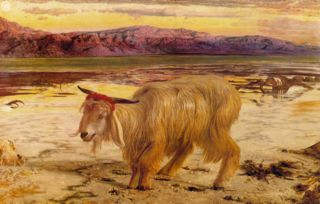
Acharei Mot is the 29th weekly Torah portion in the annual Jewish cycle of Torah reading. It is the sixth weekly portion in the Book of Leviticus, containing Leviticus 16:1–18:30. It is named after the fifth and sixth Hebrew words of the parashah, its first distinctive words.

The Foundation Stone, or the Noble Rock is the rock at the center of the Dome of the Rock in Jerusalem. It is also known as the Pierced Stone, because it has a small hole on the southeastern corner that enters a cavern beneath the rock, known as the Well of Souls.

Tractate Middot is the tenth tractate of Seder Kodashim of the Mishnah and of the Talmud. This tractate describes the dimensions and the arrangement of the Temple Mount in Jerusalem, and the Second Temple buildings and courtyards, various gates, the altar of sacrifice and its surroundings, and the places where the Priests and Levites kept watch in the Temple.
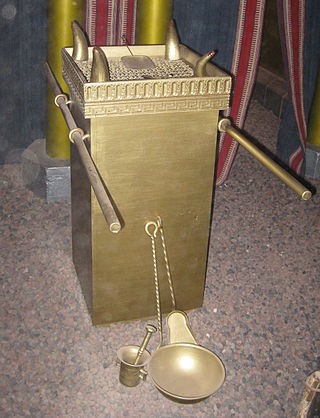
The incense offering in Judaism was related to perfumed offerings on the altar of incense in the time of the Tabernacle and the First and Second Temple period, and was an important component of priestly liturgy in the Temple in Jerusalem.
Altars in the Hebrew Bible were typically made of earth or unwrought stone. Altars were generally erected in conspicuous places. The first time the word altar is mentioned and recorded in the Hebrew Bible is that it was erected by Noah, although it does not specify that there was an altar in. Other altars were erected by Abraham, by Isaac, by Jacob, by Moses, and by Saul.
